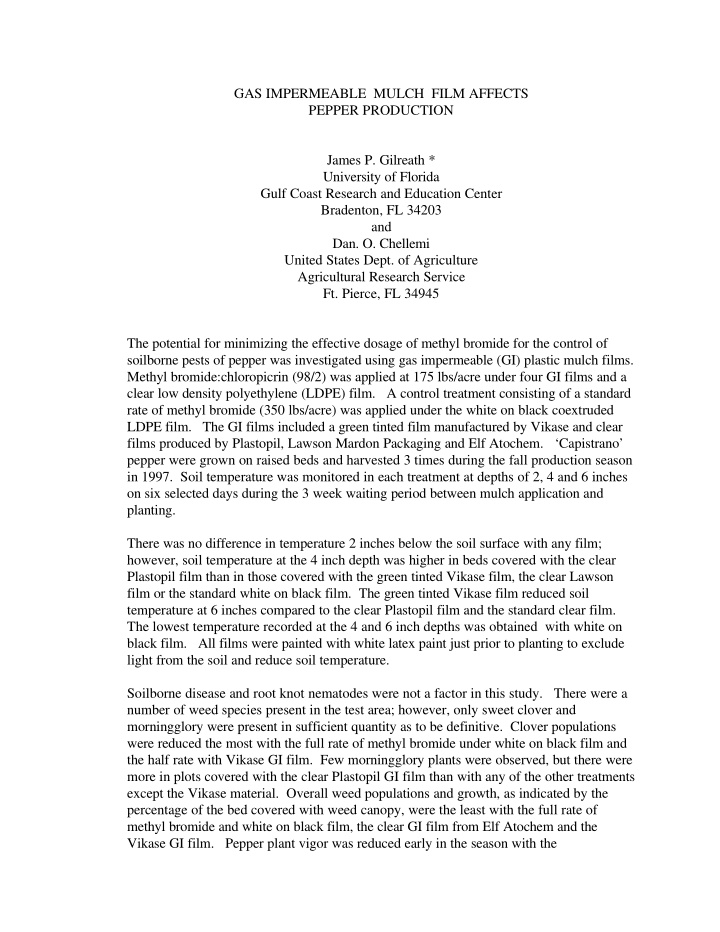



GAS IMPERMEABLE MULCH FILM AFFECTS PEPPER PRODUCTION James P. Gilreath * University of Florida Gulf Coast Research and Education Center Bradenton, FL 34203 and Dan. O. Chellemi United States Dept. of Agriculture Agricultural Research Service Ft. Pierce, FL 34945 The potential for minimizing the effective dosage of methyl bromide for the control of soilborne pests of pepper was investigated using gas impermeable (GI) plastic mulch films. Methyl bromide:chloropicrin (98/2) was applied at 175 lbs/acre under four GI films and a clear low density polyethylene (LDPE) film. A control treatment consisting of a standard rate of methyl bromide (350 lbs/acre) was applied under the white on black coextruded LDPE film. The GI films included a green tinted film manufactured by Vikase and clear films produced by Plastopil, Lawson Mardon Packaging and Elf Atochem. ‘Capistrano’ pepper were grown on raised beds and harvested 3 times during the fall production season in 1997. Soil temperature was monitored in each treatment at depths of 2, 4 and 6 inches on six selected days during the 3 week waiting period between mulch application and planting. There was no difference in temperature 2 inches below the soil surface with any film; however, soil temperature at the 4 inch depth was higher in beds covered with the clear Plastopil film than in those covered with the green tinted Vikase film, the clear Lawson film or the standard white on black film. The green tinted Vikase film reduced soil temperature at 6 inches compared to the clear Plastopil film and the standard clear film. The lowest temperature recorded at the 4 and 6 inch depths was obtained with white on black film. All films were painted with white latex paint just prior to planting to exclude light from the soil and reduce soil temperature. Soilborne disease and root knot nematodes were not a factor in this study. There were a number of weed species present in the test area; however, only sweet clover and morningglory were present in sufficient quantity as to be definitive. Clover populations were reduced the most with the full rate of methyl bromide under white on black film and the half rate with Vikase GI film. Few morningglory plants were observed, but there were more in plots covered with the clear Plastopil GI film than with any of the other treatments except the Vikase material. Overall weed populations and growth, as indicated by the percentage of the bed covered with weed canopy, were the least with the full rate of methyl bromide and white on black film, the clear GI film from Elf Atochem and the Vikase GI film. Pepper plant vigor was reduced early in the season with the
15-1 clear Plastopil film. All of the gas impermeable films reduced pepper fruit production in each of the three harvests and for the season total. Highest seasonal yields were obtained with the standard clear film using a 175 lb. rate of methyl bromide. The next highest yield was produced with the full rate of methyl bromide and white on black film, while the GI films had the lowest yields.
15-2
Recommend
More recommend